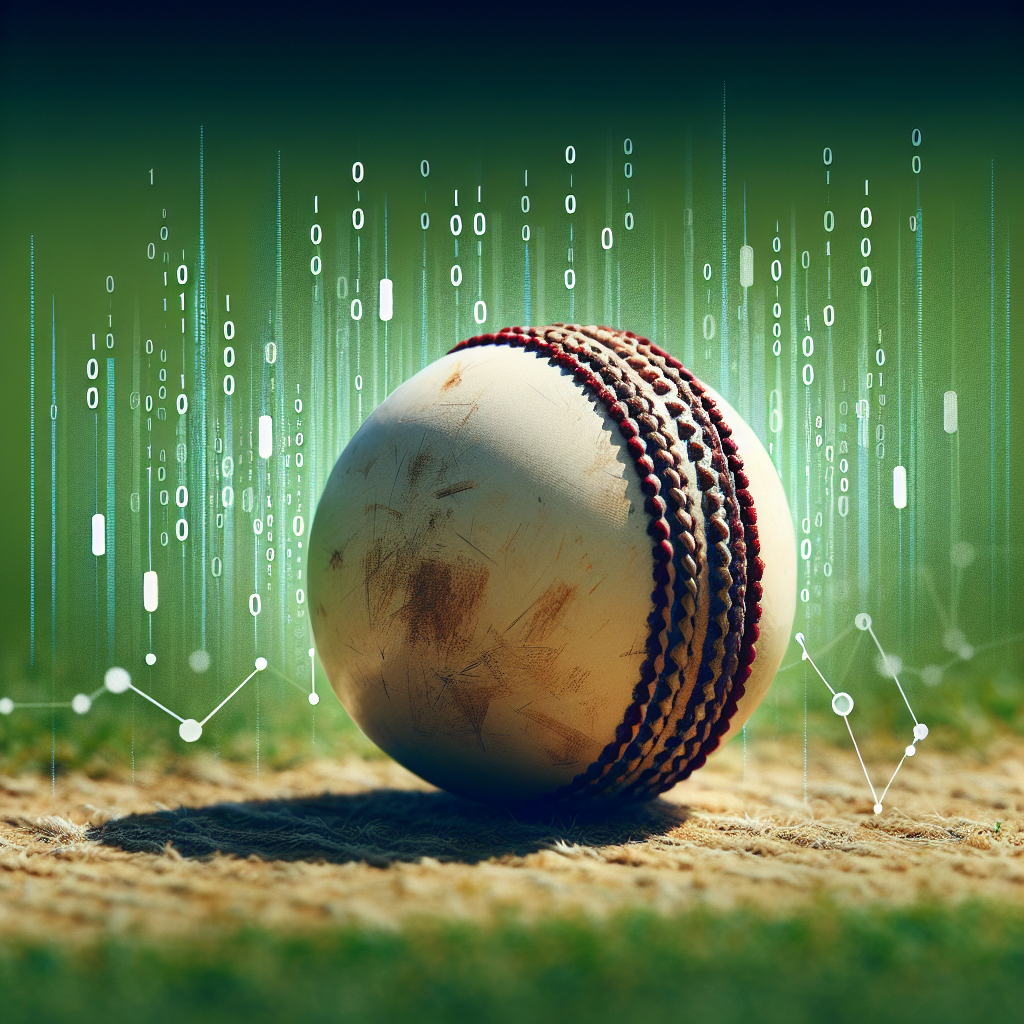Cricket, once known for its traditional and artistic style, is rapidly moving into the realm of data-driven analysis. With the rise of cricket analytics, the game is undergoing a revolutionary transformation. Gone are the days of mere gut instincts and subjective judgments. Now, cricket teams are harnessing the power of data to unravel the intricacies of the sport and gain a competitive edge. From player performance evaluations to strategic decision-making, this article explores how data is reshaping the landscape of cricket and revolutionizing the way the game is played and understood.
Understanding Cricket Analytics
Cricket analytics is the practice of collecting, analyzing, and interpreting data related to the sport of cricket. It involves using statistical models and advanced technologies to gain insights into various aspects of the game. From the performance of individual players to the strategic decisions made by teams, cricket analytics provides valuable information that can be used to enhance the overall quality of the game.
Defining cricket analytics
In simple terms, cricket analytics refers to the process of analyzing cricket-related data to gain insights and make informed decisions. This includes collecting data on various aspects of the game, such as player performance, team strategies, and match outcomes. The data is then analyzed using statistical methods and advanced technologies to identify patterns, trends, and correlations that can aid in decision-making.
Historical context of cricket data and statistics
The use of data and statistics in cricket can be traced back several decades. In the early years of the sport, basic records of matches and player performances were maintained, but the depth and complexity of the data were limited. Over time, as technology advanced and data collection methods improved, cricket statisticians began to delve deeper into the numbers, analyzing various aspects of the game.
Advancements in cricket analytics technologies
With the advent of new technologies and the availability of vast amounts of data, cricket analytics has evolved significantly in recent years. The use of advanced software, data visualization tools, and artificial intelligence has allowed teams, coaches, and analysts to delve much deeper into the intricacies of the game. Factors such as ball speed, swing, spin, and pitch conditions can now be analyzed in real-time, providing valuable insights that were previously unattainable.
Revolution of Game Strategies
Impact of analytics on strategic decisions
Cricket analytics has had a profound impact on the strategic decisions made by teams and coaches. By analyzing data on opposition teams, player strengths and weaknesses, and historical performance trends, teams can develop data-driven strategies that have a higher chance of success. For example, analyzing the batting patterns of individual players can help teams devise effective bowling tactics to exploit their weaknesses.
Role of predictive modeling in game strategies
Predictive modeling plays a crucial role in shaping game strategies. By using historical data and statistical models, teams can predict the performance of the opposition and optimize their own strategies accordingly. For instance, predictive models can help determine the ideal batting order based on player statistics and historical performance against specific bowlers or conditions. This allows teams to maximize their chances of success by making informed decisions.
Case studies of winning strategies influenced by analytics
Several notable case studies demonstrate the impact of cricket analytics on game strategies. One such example is the use of data analytics by the Mumbai Indians in the Indian Premier League (IPL). By analyzing player statistics, opposition strengths and weaknesses, and match conditions, the team was able to devise highly effective strategies that resulted in multiple championship wins. Similarly, the use of analytics by the Australian cricket team during the 2019 Ashes series played a crucial role in their success against England.
Player Performance and Analytics
Player performance metrics
Cricket analytics provides a wide range of metrics to measure player performance. These metrics include batting averages, bowling averages, strike rates, economy rates, and fielding statistics. By analyzing these metrics, teams and coaches can assess the strengths and weaknesses of individual players and make informed decisions regarding team selection, player roles, and areas for improvement.
Role of analytics in player selection and scouting
Cricket analytics has become an invaluable tool in player selection and scouting. By analyzing player statistics and performance metrics, teams can identify talent from domestic leagues, assess the potential of young players, and make informed decisions regarding team composition. Analytics allows teams to go beyond subjective opinions and rely on objective data to identify players who have the skills and potential to perform at the highest level.
Use of analytics in player training and development
Cricket analytics plays a key role in player training and development. By analyzing individual performance metrics and identifying areas for improvement, coaches and support staff can tailor training programs and practice sessions to address specific weaknesses. For example, analytics can help identify batting techniques that need improvement, bowling strategies that can be refined, or fielding skills that can be enhanced. This targeted approach to training can greatly contribute to the overall development of players.
Match Prediction and Betting
Using predictive analytics for cricket betting
Predictive analytics has also found its way into cricket betting. By analyzing historical match data, player performances, and other relevant factors, predictive models can be developed to forecast the outcome of matches. Betting enthusiasts can use these predictions to make informed bets, increasing their chances of success. However, it is important to note that betting should be done responsibly and within legal and ethical boundaries.
Role of big data in match prediction
Big data plays a crucial role in match prediction as it allows for the analysis of vast amounts of historical data from various sources. By combining data from different matches, tournaments, and players, analysts can identify patterns and trends that can be used to predict match outcomes. The availability of extensive data sets enables analysts to make more accurate predictions and provides a more comprehensive understanding of the game.
Legal and ethical implications of cricket analytics in betting
While the use of cricket analytics in betting can provide insights and improve prediction accuracy, it also raises important legal and ethical considerations. Betting laws and regulations vary across different jurisdictions, and it is important for individuals to understand and comply with the legal frameworks in place. Additionally, responsible gambling practices should be followed to ensure that the use of analytics in betting does not lead to harmful behaviors or addiction.
Fan Engagement and Cricket Analytics
Transforming viewer experience with analytics
Cricket analytics has the power to transform the viewer experience by providing enhanced insights and analysis. With the use of advanced technologies and data visualization tools, broadcasters and media outlets can present statistics, graphics, and interactive elements that enhance the understanding and enjoyment of the game. Real-time analytics can provide viewers with instant insights into player performance, match dynamics, and strategic decisions.
Use of analytics in fan engagement strategies
Cricket analytics has also played a significant role in fan engagement strategies. By analyzing fan preferences, viewing patterns, and social media interactions, teams, leagues, and broadcasters can tailor their content, promotions, and engagement strategies to capture the interest and attention of fans. Personalized experiences, interactive platforms, and behind-the-scenes insights can be made possible through the use of analytics, creating a more immersive and engaging experience for fans.
Impact on cricket broadcasting and commentary
Cricket analytics has had a profound impact on cricket broadcasting and commentary. Analysts and commentators now have access to real-time data and insights that enrich their commentary and analysis. From discussing player statistics to predicting outcomes based on historical data, cricket analytics has become an integral part of the broadcasting experience. The use of analytics in broadcasting has revolutionized the way the game is presented and analyzed, enhancing the viewing experience for fans.
Role of Artificial Intelligence in Cricket
Usage of machine learning algorithms in cricket analytics
Artificial Intelligence (AI) and machine learning algorithms have found applications in various aspects of cricket analytics. By training algorithms on large datasets, AI can analyze player performances, predict match outcomes, and identify patterns and trends that may not be apparent to human analysts. Machine learning algorithms can also continuously improve their predictions and insights as they analyze more data, leading to more accurate and reliable analytics.
Predictive modeling using artificial intelligence
Artificial Intelligence is also widely used in predictive modeling for cricket analytics. By training AI algorithms on historical match data, these models can forecast the performance of individual players, predict match outcomes, and develop strategies to maximize chances of success. The use of AI-driven predictive modeling allows teams and coaches to make data-driven decisions that are backed by advanced statistical analysis and insights.
AI-driven cricket simulations and prediction models
AI-driven cricket simulations and prediction models have become increasingly popular in recent years. These models use AI algorithms to simulate matches, predict outcomes, and analyze various game scenarios. Cricket simulations provide valuable insights into how different variables, such as player performance, weather conditions, and pitch characteristics, can impact match results. These models are also used in fantasy cricket applications and gaming platforms, allowing fans to engage with the game in a unique and interactive manner.
Challenges in Cricket Analytics
Data collection and management challenges
One of the primary challenges in cricket analytics is the collection and management of data. The sheer volume of data generated during matches, including ball-by-ball statistics, player movements, and video footage, can be overwhelming. Ensuring the accuracy, consistency, and accessibility of this data requires robust systems and technologies. Additionally, integrating data from multiple sources, such as historical records and live feeds, poses further challenges in terms of data quality and synchronization.
Ethical issues in cricket analytics
The use of cricket analytics raises important ethical considerations. Privacy concerns must be addressed when collecting and analyzing player data, ensuring that personal information remains confidential and is only used for legitimate purposes. Additionally, the potential for bias and discrimination in player selection and decision-making should be carefully monitored and mitigated. It is important that cricket analytics is conducted in an ethical manner that respects the rights and well-being of individuals.
Resistance and skepticism towards analytics within the cricket community
Despite the numerous benefits and advancements in cricket analytics, there remains resistance and skepticism within the cricket community. Traditionalists often argue that the reliance on analytics takes away from the intuition and skills of players and coaches. Additionally, there may be a lack of awareness or understanding of how analytics can enhance decision-making and improve performance. Overcoming these barriers requires education, awareness, and demonstrating the practical benefits of analytics in improving the game.
Case Study: Impact of Analytics on Major Cricket Events
Use of analytics in ICC World Cup
The ICC World Cup, the pinnacle of international cricket, has seen a significant impact of analytics in recent years. Teams and coaches analyze data on opposition teams, player performances, and historical trends to develop effective strategies. The use of analytics has helped teams identify opposition weaknesses, devise bowling plans, and optimize batting orders. The 2019 edition of the ICC World Cup witnessed several close matches and thrilling contests, with analytics playing a vital role in shaping the strategies employed by teams.
Data strategy and execution during Ashes Series
The Ashes, the historic test series between England and Australia, has seen the effective use of data strategy in recent years. The Australian cricket team used analytics extensively during the 2019 Ashes series, analyzing player performances, historical data, and match conditions to develop game plans. The insights gained from analytics helped the team make informed decisions regarding player selection, field placement, and bowling tactics, ultimately leading to their success in the series.
Impact of analytics in IPL (India Premier League)
The Indian Premier League (IPL), one of the most popular domestic T20 cricket leagues in the world, has witnessed a significant impact of analytics. Teams analyze player statistics, opposition strategies, and match conditions to optimize their chances of success. The use of analytics has helped teams identify the right mix of players, devise effective bowling and batting strategies, and make informed decisions during matches. The success of teams like the Mumbai Indians, who have consistently employed data-driven strategies, showcases the impact of analytics in the IPL.
Future of Cricket Analytics
Emerging trends in cricket analytics
The future of cricket analytics is promising, with several emerging trends that are set to revolutionize the way the game is understood and played. One such trend is the use of real-time analytics, where players, coaches, and analysts can access and analyze data during matches, allowing for immediate insights and decision-making. Another trend is the integration of wearable technology and sensors, which can provide real-time data on player movements, health, and fatigue levels, enabling teams to optimize player performance and reduce the risk of injuries.
Role of technology and innovation in shaping the future
Technology and innovation will continue to play a crucial role in shaping the future of cricket analytics. Advancements in data collection methods, data processing algorithms, and artificial intelligence will provide teams, coaches, and analysts with even more powerful tools to analyze and interpret cricket data. Additionally, the use of virtual reality and augmented reality technologies may further enhance the viewer experience, providing immersive and interactive ways to engage with the game.
Predictions for the growth of cricket analytics
The growth of cricket analytics is expected to continue at a rapid pace. As more data becomes available and technology advances, the depth and complexity of cricket analytics will increase. Predictive modeling and machine learning algorithms will become more accurate and reliable, providing teams with invaluable insights and strategies. Furthermore, the integration of analytics in broadcasting, fan engagement, and betting is likely to further enhance the popularity and significance of cricket analytics.
Significance of Cricket Analytics in Other Sports
Application of cricket analytics principles in other sports
The principles and methodologies of cricket analytics can be applied to other sports as well. Many aspects of cricket, such as player performance metrics, strategic decision-making, and match prediction, have parallels in other sports. By adopting similar analytics approaches, sports such as baseball, basketball, and soccer can also benefit from data-driven decision-making, enhanced player performance, and improved fan engagement.
Comparison of cricket analytics with other sports analytics
While there are similarities between cricket analytics and analytics in other sports, there are also unique characteristics and challenges in each sport. Cricket analytics, for example, must account for the different formats of the game (e.g., test matches, one-day internationals, T20), unique player roles, and the impact of environmental factors such as pitch conditions. Understanding these nuances and tailoring analytics approaches accordingly is essential for successful implementation and utilization in any sport.
Potential benefits and challenges of cross-sport analytics adoption
The adoption of cross-sport analytics can bring significant benefits, such as the transfer of knowledge and best practices from one sport to another. Different sports face similar challenges in terms of data collection, analysis, and decision-making, and lessons learned in one sport can be applied to another. However, there are also challenges in terms of adapting analytics approaches to the unique characteristics of each sport and ensuring that analytics-driven decisions are relevant and effective. Collaboration and the sharing of expertise between sports and analytics communities can help overcome these challenges and unlock the potential of cross-sport analytics adoption.
In conclusion, cricket analytics has revolutionized the game by providing teams, coaches, and analysts with valuable insights and data-driven strategies. From enhancing game strategies to improving player performance, predicting match outcomes, and transforming the viewer experience, cricket analytics has become an integral part of the sport. As technology advances and the availability of data continues to grow, cricket analytics is expected to further evolve and shape the future of the game, while also finding applications in other sports. The potential benefits are vast, but it is essential to navigate the ethical and practical challenges associated with cricket analytics to ensure its responsible and meaningful implementation.



